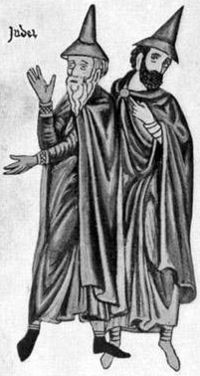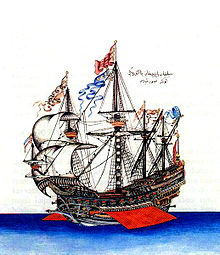History of the Jews in Europe
| Part of a series on |
| Jews and Judaism |
|---|
Judaism in Europe has a long history, beginning in the Roman Empire period as Jews displaced after the Bar Kokhba revolt were dispersed throughout the Empire.
The pre-World War II population of European Jews is estimated at close to 9 million (1.5%). About two thirds of these were killed in the Holocaust of 1940-1945. Further population drain is due to emigration, and the current Jewish population of Europe is estimated at ca. 2 million (0.3%), composed of
- Ashkenazi Jews (about 1.4 million, mostly German and Polish)
- Sephardi Jews (about 0.3 million, mostly Spanish)
- Mizrahi Jews (about 0.3 million, mostly French)
- Italian Jews (some 50,000, mostly Italian)
- Romaniotes (some 6,000, mostly Greek)
Demographics
Jewish ethnic subdivisions of Europe
- Ashkenazim (German Jews)
- Sephardim (Iberian/Hispanic Jews of Portugal and Spain)
- Romaniotes (Greek Jews)
- Italian Jews (also known as Bnei Roma)
- Georgian Jews and Armenian Jews
- Karaites (A small sect of observant Jews in the Crimean Peninsula of the Ukraine).
History

Early presence
Hellenistic Judaism was present throughout the Roman Empire even before the Roman-Jewish Wars. As early as the middle of the 2nd century BC, the Jewish author of the third book of the Oracula Sibyllina, addressing the "chosen people," says: "Every land is full of thee and every sea." The most diverse witnesses, such as Strabo, Philo, Seneca, Cicero, and Josephus, all mention Jewish populations in the cities of the Mediterranean. Most Jewish population centers of this period were however still in the Orient (Iudaea and Syria) and in Egypt (Alexandria was by far the most important of the Jewish communities, the Jews in Philo's time were inhabiting two of the five quarters of the city). Nevertheless, in Rome, at the commencement of the reign of Caesar Augustus, there were over 7,000 Jews: this is the number that escorted the envoys who came to demand the deposition of Archelaus.
Roman Empire period presence of Jews in Croatia date to the 2nd century, in Pannonia to the 3rd to 4th century. A fingerring with a Menorah depiction found in Augusta Raurica (Kaiseraugst, Switzerland) in 2001 attests to Jewish presence in Germania Superior.[1]
Evidence in towns north of the Loire or in southern Gaul date to the fifth and sixth centuries.[2]
Middle Ages
Persecution of Jews in Europe begins in the High Middle Ages in the context of the Crusades. In the First Crusade (1096) flourishing communities on the Rhine and the Danube were utterly destroyed; see German Crusade, 1096. In the Second Crusade (1147) the Jews in France were subject to frequent massacres. The Jews were also subjected to attacks by the Shepherds' Crusades of 1251 and 1320. The Crusades were followed by expulsions, including in, 1290, the banishing of all English Jews; in 1396, 100,000 Jews were expelled from France; and, in 1421 thousands were expelled from Austria. Many of the expelled Jews fled to Poland.[3]
In the Late Middle Ages, as the Black Death epidemics devastated Europe in the mid-14th century, annihilating more than a half of the population, Jews were taken as scapegoats. Rumors spread that they caused the disease by deliberately poisoning wells. Hundreds of Jewish communities were destroyed by violence. Although the Pope Clement VI tried to protect them by the July 6, 1348 papal bull and another 1348 bull, several months later, 900 Jews were burnt alive in Strasbourg, where the plague hadn't yet affected the city.[4]
Golden age of Jewish culture in Spain
The Golden age of Jewish culture in Spain refers to a period of history during the Muslim rule of Iberia in which Jews were generally accepted in society and Jewish religious, cultural and economic life blossomed. This "Golden Age" is variously dated from the 8th to 12th centuries.
Al-Andalus was a key center of Jewish life during the Middle Ages, producing important scholars and one of the most stable and wealthy Jewish communities. A number of famous Jewish philosophers and scholars flourished during this time, most notably Maimonides.
Spanish Inquisition

See main article: Spanish Inquisition
The Spanish Inquisition was established in 1478 by Catholic Monarchs Ferdinand and Isabella to maintain Catholic orthodoxy in their kingdoms and was under the direct control of the Spanish monarchy. It was not definitively abolished until 1834, during the reign of Isabel II.
The Inquisition, as an ecclesiastical tribunal, had jurisdiction only over baptized Christians. However, since Jews (in 1492) and Muslim Moors (in 1502) had been banished from Spain, jurisdiction of the Inquisition during a large part of its history extended in practice to all royal subjects. The Inquisition worked in large part to ensure the orthodoxy of recent converts known as conversos or marranos.
19th century

In the Papal States, which existed until 1870, Jews were required to live only in specified neighborhoods called ghettos. Until the 1840s, they were required to regularly attend sermons urging their conversion to Christianity. Only Jews were taxed to support state boarding schools for Jewish converts to Christianity. It was illegal to convert from Christianity to Judaism. Sometimes Jews were baptized involuntarily, and, even when such baptisms were illegal, forced to practice the Christian religion. In many such cases the state separated them from their families. See Edgardo Mortara for an account of one of the most widely publicized instances of acrimony between Catholics and Jews in the Papal States in the second half of the 19th century.
The movement of Zionism originates in the late 19th century. In 1883, Nathan Birnbaum founded Kadimah, the first Jewish student association in Vienna. In 1884, the first issue of Selbstemanzipation (Self Emancipation) appeared, printed by Birnbaum himself. The Dreyfus Affair, which erupted in France in 1894, profoundly shocked emancipated Jews. The depth of antisemitism in a country thought of as the home of enlightenment and liberty led many to question their future security in Europe. Among those who witnessed the Affair was an Austro-Hungarian (born in Budapest, lived in Vienna) Jewish journalist, Theodor Herzl, who published his pamphlet Der Judenstaat ("The Jewish State") in 1896 and Altneuland ("The Old New Land") [1] in 1897. He described the Affair as a personal turning point, Before the Affair, Herzl had been anti-Zionist; afterwards he became ardently pro-Zionist. In line with the ideas of 19th century German nationalism Herzl believed in a Jewish state for the Jewish nation. In that way, he argued, the Jews could become a people like all other peoples, and antisemitism would cease to exist.[5]
Herzl infused political Zionism with a new and practical urgency. He brought the World Zionist Organization into being and, together with Nathan Birnbaum, planned its First Congress at Basel in 1897.[6] For the first four years, the World Zionist Organization (WZO) met every year, then, up to the Second World War, they gathered every second year. Since the war, the Congress has met every four years.
World War II and the Holocaust
The Holocaust (from the Greek ὁλόκαυστον (holókauston): holos, "completely" and kaustos, "burnt"), also known as Ha-Shoah (Hebrew: השואה), Churben (Yiddish: חורבן), is the term generally used to describe the killing of approximately six million European Jews during World War II, as part of a program of deliberate extermination planned and executed by the National Socialist regime in Nazi Germany led by Adolf Hitler.
Notes
- ^ Augusta Raurica (2005)
- ^ My Jewish Learning - European Origins
- ^ Why the Jews? - Black Death
- ^ See Stéphane Barry and Norbert Gualde, La plus grande épidémie de l'histoire ("The greatest epidemics in history"), in L'Histoire magazine, n°310, June 2006, p.47 Template:Fr icon
- ^ Hannah Arendt, 1946, ' Der Judenstaat 50 years later', also published in: Hannah Arendt, The Jew as pariah, NY, 1978, N. Finkelstein, 2002, Image and reality of the Israel-Palestine conflict, 2nd ed., p. 7-12
- ^ Zionism & The British In Palestine, by Sethi,Arjun (University of Maryland) January 2007, accessed May 20, 2007.
See also
- Jew
- Who is a Jew?
- Jewish history
- Rescue
- Bulgarian Jewry
- History of the Jews in Carpathian Ruthenia
- Galician Jews
- History of the Jews in Galicia (Central Europe)
- History of the Jews in Poland
- Italian Jews
- Lithuanian Jews
- Bessarabian Jews
- Sephardic Jews in the Netherlands
- Golden age of Jewish culture in Spain
- Religion in Europe
- List of religious populations
- Islam in Europe
- Christianity in Europe
- The YIVO Encyclopedia of Jews in Eastern Europe
